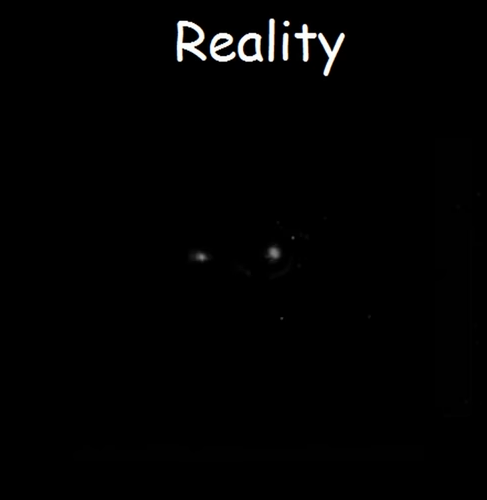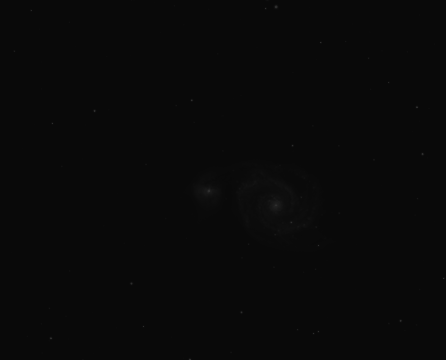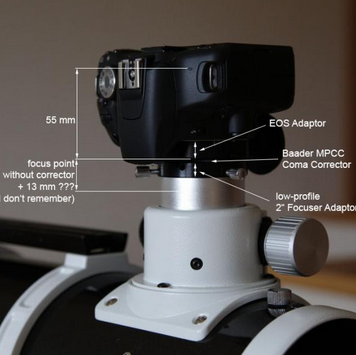
Miroslav
-
Posts
12 -
Joined
-
Last visited
Content Type
Profiles
Forums
Gallery
Events
Blogs
Posts posted by Miroslav
-
-
The RPi problem looks like good option. I own a board and no need to spend more money. But whatever I read I will need the telescope first, so I can test it

RPi + remote from smartphone or tablet sounds very good to me. It will be light I will no need laptops or much more cables.
Regards!
-
Thanks, Vlaiv!
I will read next days about Astroberry and Indigo to try understand the difference and possibilities. Also will check for PHD2 Linux Arm version.
The problem with my laptop is its battery gone long time ago
 and I use it as desktop. Also I no need another laptop so will no buy new.
and I use it as desktop. Also I no need another laptop so will no buy new.
Looking at the camera in Ali - the reviews are all positive. But let me first get familiar with the software. I am sure I will need more help in near future and will write and ask again.
Regards!
-
Thanks again guys!
It is good to know what I will need! So at the moment configuration HEQ5 and 130PDS looks good for me. Later will see.
About the giuding Vlaiv mention about using Raspberry. It sound great because I own RPi3. My laptop is old and if I can spend money from additional computer module will be good. Vlaiv, can you give me some directions about using RPi for guiding?
Also is the guidescope much different from the findscope or I can use the 130PDS finderscope, for example, as guider?
If I read correctly I will need some kind of camera for the guider, what type is it?
Probably I will need also power supply for all this gadgets?
Regards!
-
Another question - lot of people mentioned autoguiding. I though the mount can follow the objects without need of additional software. Can I do AP with mount only?
And what about Celestron Advnaced VX mount?
Regards!
-
Thanks!
HEQ5 is my choice also in case later get something bigger.
A question about 150PDS - some people said it catch too much wind, is it so much bigger than 130PDS?
Also playing with fov calculator site probably I will need reducer if I want to fit Andromenda like DSOs in a single photo.
Regards!
-
I checked the offers and will keep an eye on them.
For DYI I do not have place and tools at the moment, so will pass

Thanks for all help, and because I am not in a hurry I will checking the prices in FLO and in astroshop.eu. Because I am from Bulgaria the shipping from UK can be expensive.
Regards!
-
I know the AP is expensive. But I am sure, if I get for example an Heritage and like it, later I will still go to the AP
 That is why I try to choose between about 80mm ED refractor and 130PDS - an cheaper alternative. As I know for those two relescopes HEQ-35 is also an option, but what if later decide to upgrade the mount...?
That is why I try to choose between about 80mm ED refractor and 130PDS - an cheaper alternative. As I know for those two relescopes HEQ-35 is also an option, but what if later decide to upgrade the mount...?
Second hand items is good idea, but I do not know shop to offer used items. Do FLO offer? Because those are expensive and precise optics I would check offers form some astro-shop. I also have to check again into local forums what is the situation with old items.
Anyway at the moment looks like 130PDS is better for my needs

-
Thanks again for the good points you mentioned.
Getting two telescopes is not bad idea. Reading here and there, all people mentioned there is not one-for-all telescopes. I thought for Dobson on alt-az mount, but with them there there is an image rotations and probably later is harder to stack the photos. Or this is not so big problem?
Is there Heritage with goto?
Also when I and the kids watch we will not spend whole night, so hope the eyepiece will not move too much But stil will have to put the eyepiece at some good beginning point so I can reach it most of the time... Never though about this...
My idea was to start with HEQ5 mount and get something for photos and use it for visual also. Later if I like this hobby and spend money would get something like Dobson or SCT for better view of planets and small DSOs eventually for imaging also.
Watching the prices of HEQ5 and 130PDS I hope to spend not more than 2k Euro at first place. I know if go to ZS73 the money will be more. Getting the mount, telescope, comma corrector, the camera adapters, may be a filter or an eyepiece and my budget will gone. The good new is I am not in a hurry, I will not watch during the winter.
Regards!
-
Reading at the forums I am not the only one with this dilemma
I also checked the topics with the images from ED80 and 130PDS. I was surprised to see lot of planetary images, there few great of Jupiter with ED80. I didn't expect it. I thought 130PDS is better for the planets because of the bigger aperture, but looks like I was wrong...
And what about observing? Who of the both telescopes offer better viewing experience? I am asking, because have a kids and they will want to view something and will not wait me to shoot then process images.
I know TS telescopes, but they are too expensive. If I decide to go with a refractor I will probably get ZenithStar 73.
Regards!
-
16 hours ago, vlaiv said:
Hi and welcome to SGL.
HEQ5 + 130PDS is very nice starter setup.
Most frequently used eyepieces are 1.25" and 2" - larger ones are used when you want larger field of view.
Don't get carried away with magnification. For general observing you'll be using magnification in x30-x50 range with some targets requiring a bit more magnification (up to say x100 on small planetary nebulae). It would be good to get yourself familiar with what you'll be able to see to set your expectations right. Here is nice video explaining things:
https://www.youtube.com/watch?v=jI7IPPmu76U
In fact - you'll find several videos on this subject if you do the search:
https://www.youtube.com/results?search_query=telescope+expectation+vs+reality
For this reason - FOV calculator that show you image of object can be a bit misleading in what you'll see - as these use photos rather than trying to simulate actual targets.
Not sure if I ever observed M51 at such high power with small or even larger scope.
This looks nice, doesn't it:
But that red circle is larger than your computer screen so M51 would take up half of your screen. that is just too large / magnified.
In reality - it will be more like this:
Actual / realistic size of object that you'll see (say you are sitting 60cm away from computer screen).
That is about it - you'll see two cores and that will be at much lower magnification - like x50 or similar. Maybe, if you are lucky and have excellent night and you are in very dark location and M51 is high up in the sky, you'll be able to see it like this:
(hint of bridge and some spiral structure visible)
On different end of spectrum are planets - you'll need magnifications up to x200 realistically. In most cases you won't be able to use x200 due to atmosphere.
Not sure if you'll benefit from barlow lens at the beginning, since you are mentioning Morpheus eyepieces. Usually barlows work to get extend magnification range of few eyepieces and save money on those. Instead of jumping straight at Morpheus (skip Hyperions - they will be very poor at F/5) - look into getting nice set of BST StarGuiders. You can get like 4-5 of those for price of single Morpheus eyepiece.
Nothing wrong with Morpheus eyepieces and if you have the budget - go for them, but I think that you'll appreciate them more once you learn how to observe. Observing is a skill and you learn it by practice. Once you have some experience - then you'll now what sort of eyepieces you like. BST StarGuiders are very nice upgrade from stock eyepieces, and since you'll be using 130PDS - they will form very nice set to get you going.
You'll attach any filter to coma corrector, then coma corrector to extension tube, then extension tube to T2-Lens adapter for your camera and camera in the end. It will all look like this:
and is inserted into focuser like this:
Don't worry about type of matrix on your sensor - there is software support that will deal with getting images from raw format and making astro photography out of it. There are plenty of tutorials both on youtube and here on SGL to show how it is done.
Best filter will depend on type of light pollution that you have and target that you are imaging.
For emission type nebulae - UHC filter works very good, while for general AP look into LP suppression filters - I used to use IDAS LPS P2 because there was plenty of sodium lights in my home town. If most of LP is in form of LEDs - look into different model like IDAS LPS D4 (or whatever the actual model name is) - or ask here on SGL depending on your budget.
130PDS is different than 130P because it has DS - dual speed focuser that is made for imaging. It is good enough to hold camera and coma corrector (which is actually inserted in focuser).
Mirrorless camera is lighter than regular DSLR - so you'll be fine, and yes - you'll need T-ring for your camera model, and you'll also need to calculate proper distance. Cameras have flange focal distance - which means how far away lens must focus to properly focus on sensor itself. See here:
https://en.wikipedia.org/wiki/Flange_focal_distance
T-ring for your camera has certain optical length that is specified and coma corrector has certain working distance - you must match things to get good image:
coma corrector working distance = flange focal distance + T2 optical path length + any needed spacers.
Thank you for the nice response!
Especially for the real example of seeing M51
 ! The eyepiece will not as the screen... I missed this
! The eyepiece will not as the screen... I missed this 
Last night when I post my topic I was sleepy and miss something to mention. First I recently understand that when view DSOs they looks black and white
 because of this I will be happy to can see the biggest of Messiers like Andromeda, Lagoon nebula and Pleiades. So my real plan is get good enough photos of them. And thinking of this I again ask myself - is a small refractor telescope (ED80 or ZS73) be a better option? Yes they are more expensive, but also smaller and probably better for AP. If viewing experience over some of those refractor would be same, may be it will be better to get one of them?
because of this I will be happy to can see the biggest of Messiers like Andromeda, Lagoon nebula and Pleiades. So my real plan is get good enough photos of them. And thinking of this I again ask myself - is a small refractor telescope (ED80 or ZS73) be a better option? Yes they are more expensive, but also smaller and probably better for AP. If viewing experience over some of those refractor would be same, may be it will be better to get one of them?
And talking about you real example above
 the situation with the planets will not be better than with M51. In this case is realistic to try 250-260x with this telescope and try to get images of the planets, or someday just to get 6" or 8" SC telescope, if I can spend money
the situation with the planets will not be better than with M51. In this case is realistic to try 250-260x with this telescope and try to get images of the planets, or someday just to get 6" or 8" SC telescope, if I can spend money  ?
?
I like "Observing is a skill and you learn it by practice"! As newbie it is hard to understand it completely, but I believe you are right and will follow your advice. Actually I have few cheap eyepieces, and before order anything else, I will try them.
Thanks for the photos with the camera!
About the filters - I am living in a city with lot a light pollution, but my home place is in the yellow-blue zone. But will probably think about LP or UHC at first place.
Best regards!
-
Hi to all!
I am new in the forum and have no experience with the telescopes. For my luck I found FLO and the guys there help me a lot. Also I play with this calculator so I can try to understand what can be my first equipment. Also I want to apologize, because English is not my native language, and because of this I may ask more than usual

My idea is to use HEQ5 GoTo SynScan as base, in case later decide to get 6" or 8" SCT.
My first idea for telescope was ZenithStar 73, but reading here and there, and playing with the FOV calculator I changed my plans. As total beginner may be the wiser will be to get an Explorer 130PDS. There are lot of good opinions about this telescope, and there are lot of nice astro photos too. The price is also much lower.
I hope to use the telescope for visual observations and astro-photography. Testing the 150PDS in the calculator with the Messiers looks like a magnification of x130 (exit pupil about 1mm) is enough for most of the smallest objects in the list. Testing the telescope with Jupiter, Saturn, Venus and Mars, and exit pupil about 0.5 (magnification about 200x) I may get acceptable views of them.
I accept corrections and comments about all above because it is only "on paper"

The 150PDS come with 2" focuser and adapter for 1.25" if I am not wrong, also "Eyepiece Supplied 28mm (2"/50.8mm)" - I am not sure how to understand this. Looks like I will need one or two more eyepieces and a Barlow/Powermate. And I am not sure how to combine them.
For example the Whirlpool galaxy is good at 130x. This mean 2x barlow and 10mm eyepiece or just 5mm eyepiece. For Lagoon nebula 28mm with 2x barlow is OK. For Jupiter 2x barlow with 5mm eyepiece (260x and exit pupil about 0.5) is may be the maximum I can get.
Talking about the barlows, is the performance of the powermate worth the bigger price?
I read on some place the small eyepieces (high magnification) are usually 1.25", the big eyepieces (as 28") are 2". I looked at Baader eyepieces betweeh 4.5 and 12mm, all of them can be used with 2" and 1.25". So what Barlow/Powermate is wiser to buy - 1.25" or 2"? If I got 1.25" x2 is there adapter for 2" eyepieces?
I read very good opinions about Baader Hyperion and Morpheus, but if someone recommend me alternatives will be nice to know.
Another thing I do not understand is where I have to attach the Comma Correcter and some light pollution/nebulae filter - at the focuser or on some of the other parts of the system?
Also it will be great if someone recommend me first filter. I will use not modified Fujifilm X-T3 camera. In astrobackyard recommended filter is CLS type. Looking for those filters in FLO I spotted in their names CCD, is that mean they are for CCD matrix? Mine must be BSI, if I am not wrong, with X-Trans layer, not Bayer, who is typical for Fuji crop cameras.
Another question is - is the focuser strong enough to attach on it barlow/powermate, eyepiece and at the end my mirrorless camera? Talking with the guys from FLO it looks like I can attach the camera wherever I want with proper T-Rings.
Thanks and best regards!










Plans for a beginner equipment
in Getting Started Equipment Help and Advice
Posted
Thanks!
I know those mini PCs, and if my RPi is to slow probably I will get some other mini PC.
Just to compare my Odroid N2+ was about 150 Euro